Introduction
Sometime back there was a news item that Iran has decided to undertake construction of the Chabahar- Zahedan Railway Line on its own. The reason given was that India who was earlier building that Railway line was going slow on the project as there were issues of funding.
Back Ground- During PM Modi’s visit to Iran in 2016 there were in all 12 Accord/MoUs signed.1 There are two of those MoUs at serial 6 and 11 respectively are relevant for the discussions on the subject. These two are as follows: -
- Bilateral contract on Chabahar Portfor port development and operations between IPGPL
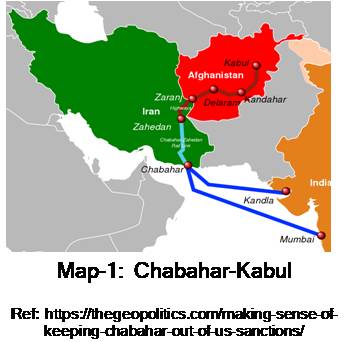 [India Ports Global Private Limited] and Arya Bander of Iran: The contract envisages development and operation for 10 years of two terminals and 5 berths with cargo handling [multipurpose and general] capacities.
[India Ports Global Private Limited] and Arya Bander of Iran: The contract envisages development and operation for 10 years of two terminals and 5 berths with cargo handling [multipurpose and general] capacities. - MoU Between IRCON of India and Construction, Development of Transport and Infrastructure Company (CDTIC) of Iran: MoU will enable IRCON to provide requisite services for the construction of Chabahar-Zahedan railway line which forms part of transit and transportation corridor in trilateral agreement between India, Iran and Afghanistan. Services to be provided by IRCON include all superstructure work and financing the project (around USD 1.6 billion).
Progress of the Project
- Port Project- Phase-1 of the port project got completed in Dec 2017. An Indian company has already started operating some terminals of the Chabahar port since 2018. Since Dec 2018, 82 vessels have already been handled there; including 52 in last 12 months. The port has already handled 12 Lakh tons of cargo and 8200 containers. Proactive measures are currently underway to increase the usage of Chabahar port.2 India has already invested $500 million in the project.
- Chabahar- Zahedan Railway Line- IRCON was appointed by the government of India to assess the feasibility of the project. IRCON had pledged to provide all services and funding for the project to the tune of $1.6 billion. For this it was working with the CDTIC, an Iranian company under the Ministry of Railways in Iran. IRCON has completed the site survey and the review of the Feasibility Report. There were some issues including financial challenges. All these were discussed during 19th India -Iran Joint Commission Meeting at Tehran during December 2019. Iran was required to nominate an authorised agency to finalise technical and financial issues. The details are still awaited.4 Now suddenly it has been reported that Iran was dropping India in the development of the Chabahar-Zahedan rail project, a showpiece of Afghanistan-Iran-India trilateral co-operation.The Iranian government announced on 14 Jul 2020 that it will proceed with the construction of a railway line linking the Chabahar port with Afghanistan on its own, citing delays from India in funding and starting the project.5 Iran refuted this report and claimed that there had not been any agreement with India for this project.6 Iran however clarified later, that India can join the Chabahar- Zahedan railway project later.7 According to reports, Iran Railways has already started laying track for the 628 km railway project. It is expected that the full length of the track would be completed by March 2022.
3
8
Creeping Influence of China
Was it a sudden decision on the part of Iran or was it influenced by some external factors? Post revolution of 1979, Iran was guided by the slogan for the reconstruction of a post-revolution Iran, given by her supreme leader of that time; Ayatollah Khomeini,“Neither East, nor West”! Now; fresh reports of a likely wide-ranging strategic pact which is expected to be signed between Iran and China (details have been leaked In a New York Times report9) indicates that Iran is moving away from this slogan.
As per this accord China will invest $400billion in Iran in next 25 years in energy and other sectors. Iran appears to have gone for it to reduce the impact of the Trump Administration’s efforts to isolate Iran; post imposition of sanctions in 2018 based on suspected involvement of Iran in nuclear proliferation and her military ambition. This accord will enhance presence of China in Iran in banking, telecommunications, ports and railways. In return China will have access to heavily discounted supply of oil for next 25 years.10 Iran will become a crucial pivot of China’s Belt and Road Initiative (BRI); linking China to Europe.The document further adds that the accord will deepen military cooperation and thus giving China a foot hold in the region. The proposal outlines joint training and exercises, joint research and weapons development and intelligence sharing in "the lopsided battle with terrorism, drug- and human-trafficking and cross-border crimes".
China had been pursuing the deal since 2016 when President of China; Xi Jinping proposed it during his visit to Iran. It has been approved by the Iranian cabinet in June 2020. The next step is its approval by the Islamic Consultative Assembly of Iran (Parliament). However, it has not yet been presented there.11 It would indeed be a big blow to current US administration’s aggressive policy towards Iran since herwithdrawal from Joint Comprehensive Plan of Action (JCPOA) for nuclear deal with Tehran reached in 2015 during previous US administration between P-5+1 (all five permanent members of the UN Security Council + Germany) and Iran. It would also push India to a very awkward position in her relationship with Iran (more about it later). The withdrawal Of US from the JCPOA for the Nuclear deal and subsequent sanctions by the US against Iran has already pushed the desperate Iran to look for alternate options and a deal with China just fits the bill. Their (Iran and Chian) respective needs; complement each other. Iran needs technology and China needs oil (China gets about 75 percent of its oil from abroad and is the world’s largest importer, at more than 10 million barrels a day last year).12 China after this deal will get assured supplies of Iranian oil, gas and petroleum products at highly discounted prices. China also feels that she is in a position to defy the United States who is affected by a recession and this one deal will put her in a better position in her trade war with US; though there is a fear that Chinese companies dealing with Iran may invite punitive action by US. The expansion of military assistance, training and intelligence-sharing will be a cause of alarm for US especially in Persian Gulf. No wonder; Pentagon’s National Security Strategy has declared China an adversary.13 However it needs to be noted that the projects mentioned in the deal are in keeping with China’s vision to extend its economic and strategic influence across Eurasia through the BRI. The agreement also includes proposals for China to build the infrastructure for a 5G telecommunications network.Moving ahead with a broad investment program in Iran appears to signal Beijing’s growing impatience with the Trump administration after its abandonment of the nuclear agreement. Iran and China both view this deal as a strategic partnership in not just expanding their own interests but confronting the U.S.A.14 One of the reasons for the deal is that Iran wishes to remain a serious player in the energy market and her willingness to go to any extent for this objective and China with her deep pockets flushedwith; over $ three trillion of Forex reserve15 is ready to defy US and trade with Iran.
Although the deal has the support of Iran’s supreme leader, Ayatollah Ali Khamenei, it has stoked a fierce debate within Iran. The critics including former president, Mahmoud Ahmadinejad, have charged the govt of trying to sell the country to China in a moment of economic weakness and international isolation. Their argument is based on the history of the experiences of other countries in Africa and Asia, where Chinese investments have left them under heavy debt to China with consequent effect on their economic independence. 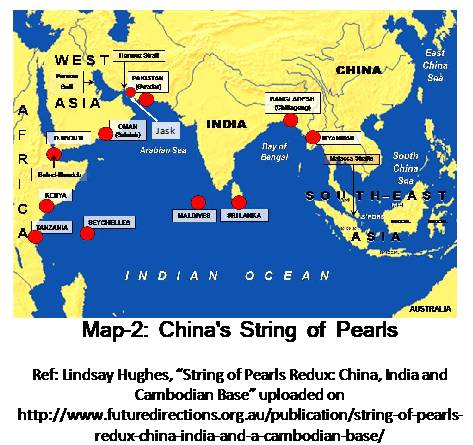 It is an example of a revolutionary mindset combining with a deep sense of Persian superiority. There are fears that Iran’s valuable natural resources will be mortgaged to an untrustworthy partner. Religious hardliners point to China’s repression of the Uighur Muslims.16 The Iranian parliament, which is presently dominated by conservatives; is likely to react strongly to any suggestion of ceding sovereignty to China for economic gains when the pact is put to them in the Parliament for their consideration.17 A particular concern has been the proposed port facilities at Jask (Bandar-e-Jask), just outside the Strait of Hormuz along the coast of the Sea of Oman. This along with other ports which China has built/ operates along the Indian Ocean and the South China Sea like Hambantota and Gwadar will provide PLA Navy a greater reach.With Gwadar having uncertain future due to unrest in Baluchistan province of Pakistan, Chinese plans of avoiding Malacca Dilemma (a term coined by previous Chinese President Hu Jintao18) is getting a setback. No wonder they are looking for alternate options in Iran. China has also already stepped up military cooperation with Iran. The PLA Navy has already visited and participated in military exercises many a times since 2014.
It is an example of a revolutionary mindset combining with a deep sense of Persian superiority. There are fears that Iran’s valuable natural resources will be mortgaged to an untrustworthy partner. Religious hardliners point to China’s repression of the Uighur Muslims.16 The Iranian parliament, which is presently dominated by conservatives; is likely to react strongly to any suggestion of ceding sovereignty to China for economic gains when the pact is put to them in the Parliament for their consideration.17 A particular concern has been the proposed port facilities at Jask (Bandar-e-Jask), just outside the Strait of Hormuz along the coast of the Sea of Oman. This along with other ports which China has built/ operates along the Indian Ocean and the South China Sea like Hambantota and Gwadar will provide PLA Navy a greater reach.With Gwadar having uncertain future due to unrest in Baluchistan province of Pakistan, Chinese plans of avoiding Malacca Dilemma (a term coined by previous Chinese President Hu Jintao18) is getting a setback. No wonder they are looking for alternate options in Iran. China has also already stepped up military cooperation with Iran. The PLA Navy has already visited and participated in military exercises many a times since 2014.
There is another perspective worth considering as argued by Abhijit Singh recently in his article in The Print.19 As per him; the Iranian Revolutionary Guards Navy (IRGCN) is not well disposed to any foreign naval presence at any of the Iranian ports. It may be noted that although India is developing Chabahar Port but the IRGCN controls the Imam Ali naval base in Chabahar. They also control Bandar-e-Jask and the island of Qeshm. The cadre of Revolutionary Guards have a two point agenda right from its inception; first; to protect the revolution and second; to counter the United States of America. As such; there have been no foreign bases on Iranian soil since 1979. Also Iran as well as US realise the importance of Chabahar for providing connectivity to the Central Asia as well as Afghanistan. Therefore, Jask or any other port being given to PLA Navy or allowing for greater Chinese influence in Gulf region appears to be highly unlikely. It may be good news for Indian planners but India should not allow any slowing down of the development of the Chabahar or cooling of Indo- Iranian Relationship. It indeed will be a test for the Indian diplomacy in the Western Indian Ocean and the Gulf Region. It will also be a challenge for India to convince about the criticality of engaging Iran for safeguarding her interests in Central Asia and supporting Afghanistan in her endeavour to free herself from remaining a captive to Pakistan’s design to restrict access to Afghanistan.
Impact on India
Consequent to the publication of the leaked draft of the Sino- Iran deal in the New York Times, it was reported that Iran had dropped India in the development of the Chabahar-Zahedan rail project, a crucial project which earlier was thought to be showpiece of Afghanistan-Iran-India trilateral cooperation and a gateway of India to Central Asia.
In past India had always implemented UN mandated sanctions against Iran but post May 2018, when USA imposed comprehensive sanctions on Iran, India made a change in her consistent foreign policy and joined US mandated trade and investment boycott of Iran, probably to woo the USA.20 Around the same time, India engaging Saudi Arabia and UAE was also noticed with dismay by Iran, which has her own issues with these two countries.India’s abrogation of Article 370 and Article 35A of the Indian Constitution; also did not go down too well with Iran. In fact the supreme leader of Iran; Ayatollah Ali Khamenei on 21 Aug 2019 tweeted Iran’s concern about Muslims in Kashmir. All these probably contributed to deterioration of the relationship between the two countries.
China is also playing on the desperation of Iran. It is interesting to note that while China is keeping her negotiations on with Iran; her import from Saudi Arabia has surged by 94% during 2020 and 71% during May 2020. In fact during May and June 2020 Saudi Arabia and Russia have been the top suppliers and not Iran21. Probably to cajole Iran into this deal. In this connection it is interesting to note that there is a deafening silence on the part of Iran regarding the ill treatment by China of the Uighur Muslims in Xinjiang. 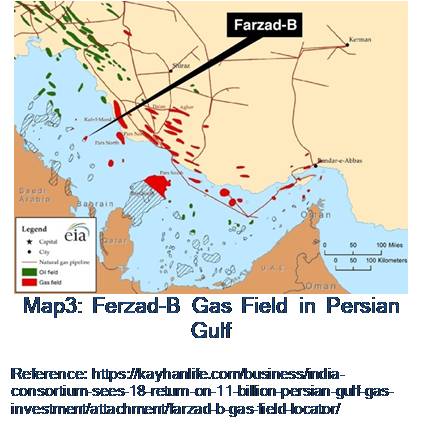 Also Iran is not very sure of the cooperation of the Western World in her fight with the COVID-19 pandemic, under the pressure of US.China found these developments as an opportunity, because her attempts of establishing a strong presence in Iran, with latter’s economic duress due to sanctions was indeed a God sent opportunity. As mentioned in earlier section the draft agreement lists nearly 100 projects, proposes three free trade zones in Maku in northwest Iran, Abadan in the southeast close to Shatt al-Arab and on Qeshm island, which would challenge Gulf Co-operation Council (GCC) dominance of trade and manufacturing in the Gulf region. Of all the projects the proposed port at Jask; which is located just west of Chabahar; is of great concern to India. May not be now, but possibility of China getting access to Chabahar cannot be ruled out. All these will provide China not only a presence in Western Indian Ocean but will also pose a challenge to maritime interests of USA (whose 5th Fleet is based in Bahrain) and India. Overall now China’s shadow looms large from Himalayas in North to Indian Ocean in South. By no stretch of imagination a comfortable state as far as India is concerned. Another casualty of Indian interest is Iran’s decision to develop Farzad B gas Field. It needs to be noted that a consortium of three Indian companies; ONGC, OIL and IOC opened this gas field which has a potential reserve of 12.8 trillion cubic feet in 2008.In August 2019 after a number of delays on account various geopolitical and economic reasons Iran announced that she was not going to wait for India to come out with a plan to develop Farzad-B gas field, and soon the project would know its operator.22 However the bottom line is the track record of China in her economic relations with others, which Iran needs to take note of. It needs to be noted that when China discusses strategic cooperation with another country the potential of billions of dollars in investments is almost always there on the table, how and when, and if, that actually materializes is a different matter.23 Iran, an inheritor of a very proud cultural civilisation, should be wary of an overt presence of China in its economy, which may have far reaching implications for her strategic and economic autonomy with consequent effects on her regional and foreign policy objectives.
Also Iran is not very sure of the cooperation of the Western World in her fight with the COVID-19 pandemic, under the pressure of US.China found these developments as an opportunity, because her attempts of establishing a strong presence in Iran, with latter’s economic duress due to sanctions was indeed a God sent opportunity. As mentioned in earlier section the draft agreement lists nearly 100 projects, proposes three free trade zones in Maku in northwest Iran, Abadan in the southeast close to Shatt al-Arab and on Qeshm island, which would challenge Gulf Co-operation Council (GCC) dominance of trade and manufacturing in the Gulf region. Of all the projects the proposed port at Jask; which is located just west of Chabahar; is of great concern to India. May not be now, but possibility of China getting access to Chabahar cannot be ruled out. All these will provide China not only a presence in Western Indian Ocean but will also pose a challenge to maritime interests of USA (whose 5th Fleet is based in Bahrain) and India. Overall now China’s shadow looms large from Himalayas in North to Indian Ocean in South. By no stretch of imagination a comfortable state as far as India is concerned. Another casualty of Indian interest is Iran’s decision to develop Farzad B gas Field. It needs to be noted that a consortium of three Indian companies; ONGC, OIL and IOC opened this gas field which has a potential reserve of 12.8 trillion cubic feet in 2008.In August 2019 after a number of delays on account various geopolitical and economic reasons Iran announced that she was not going to wait for India to come out with a plan to develop Farzad-B gas field, and soon the project would know its operator.22 However the bottom line is the track record of China in her economic relations with others, which Iran needs to take note of. It needs to be noted that when China discusses strategic cooperation with another country the potential of billions of dollars in investments is almost always there on the table, how and when, and if, that actually materializes is a different matter.23 Iran, an inheritor of a very proud cultural civilisation, should be wary of an overt presence of China in its economy, which may have far reaching implications for her strategic and economic autonomy with consequent effects on her regional and foreign policy objectives.
Be as it may, a bigger immediate setback on account of this proposed Deal would be to India. The immediate casualty is Chabahar-Zahedan Railway Line, which, as declared by Iran, will now be constructed by Iran herself and India has been dropped from the project due to funding problems and as mentioned in an earlier section work to lay tracks by Iran has already commenced since March 2020. Iran however has kept the door slightly open by declaring that India may join the project later24, probably keeping her option to use India as a counter weight to China in case the latter becomes excessively assertive. On the other side; Chinese foray into Iran indicates China’s efforts to contain India in Gulf region. In this connection post leakage of the proposed deal by the The New York Times report, it has come to light that the MoU signed during PM Modi’s visit in 2016, regding Chabahar -Zahedan Railway line; is not totally off. In this connection a statement of Iran's railway minister is significant; in which he has stated that Iran and India are "determined to continue" cooperation on the railway line.25 The statement of the Railway Minister of Iran has been corroborated by the Ministry of External affairs of India wherein it has been stated that the reports of India being left out of the prestigious Chabahar rail project is not based on facts. The spokesperson confirmed that it is a work in progress. As per him the feasibility survey has already been carried out for which IRCON was working with CDTIC, an Iranian company under their Ministry of Railways. According to the foreign affairs ministry, the issues were reviewed in detail at the 19th India-Iran Joint Commission Meeting in Tehran in December 201926 and based on the confirmation by the Indian side of the completion of the Feasibility study; the Iranian side was to nominate an authorised entity to finalise outstanding technical and financial issues; which is awaited.27 The sudden declaration by Iran that India was off from the project was baffling to say the least; after two sides had signed an MoU to work together on the Chabahar-Zahedan railway link project, though a formal agreement had not come through. It has now come to light that the issue of dispute is the entity which Iran wants the project to execute. India had objected to Khatam al-Anbiya constructions to handle the civil work, which Iran was insisting on. India's objection was with the fact that the company belongs to Iran's Islamic Revolutionary Guard Corps (IRGC) - one of the entities proscribed by the United States of America. These entities are part of USA's secondary sanctions.Under the US sanctions, countries cannot work with a designated entity in Iran even if it is for certain development projects that enjoy waiver from the US scrutiny. No wonder notwithstanding the recent announcement by Iran, negotiations continue between the two sides on how to get New Delhi involved.
Criticality: Chabahar Port and Chabahar- Zahedan Railway line for India
For bilateral trade between India and Iran, Chabahar port project is very important. Nearest government port to Chabahar in India is kandla, which is responsible for the import of the hydro carbon and chemicals28, and nearest private port in India is Mundra Port; which handles largest amounts of containers and bulk mineral service. 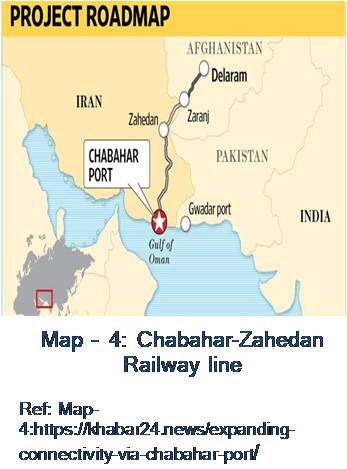 It needs to be noted that the route Kandla – Chabahar is 650 Nautical Miles and can be covered in 2.7 days at the speed of 10 Knots.29 This route cuts the transport cost/ time for Indian goods by third and will also reduce Afghanistan’s dependence on Karachi Port and thus ensure less leverage of Pakistan on Pakistan.30 For further connectivity to Afghanistan and thereafter to central Asia, it was planned to have initially
It needs to be noted that the route Kandla – Chabahar is 650 Nautical Miles and can be covered in 2.7 days at the speed of 10 Knots.29 This route cuts the transport cost/ time for Indian goods by third and will also reduce Afghanistan’s dependence on Karachi Port and thus ensure less leverage of Pakistan on Pakistan.30 For further connectivity to Afghanistan and thereafter to central Asia, it was planned to have initially
Chabahar – Zahedan (a 628 Km ) railway line up to the border which earlier was to be built by India but now is being constructed by Iran. A road from; Zaranj on the Iran- Afghanistan border to Delaram (218 km) on Afghan Garland Road; has already been built by India in 2008. 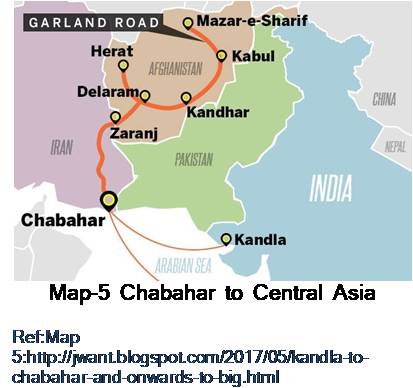 Thus;as and when the railway line between Chabahar and Zahedan gets completed (Expected date of completion is 2022); connectivity to Mazar-e-Sharif in Afghanistan and thereafter to Tajikistan from Chabahar will be possible. This multimodal connectivitywill benefit not only Afghanistan but also other countries of the region (Afghanistan and Central Asian Republics), besides providing enough of revenue to Iran on account of transit of goods. The development of physical infrastructure may also help India, Iran, and Afghanistan to maintain peace, give boost to counter-terrorism operations and fight drug menace; besides providing enough of employment during the construction phase and subsequently during maintenance of the infrastructure.
Thus;as and when the railway line between Chabahar and Zahedan gets completed (Expected date of completion is 2022); connectivity to Mazar-e-Sharif in Afghanistan and thereafter to Tajikistan from Chabahar will be possible. This multimodal connectivitywill benefit not only Afghanistan but also other countries of the region (Afghanistan and Central Asian Republics), besides providing enough of revenue to Iran on account of transit of goods. The development of physical infrastructure may also help India, Iran, and Afghanistan to maintain peace, give boost to counter-terrorism operations and fight drug menace; besides providing enough of employment during the construction phase and subsequently during maintenance of the infrastructure.
The development of Chabahar port project , which was considered, when signed, an epitome of South- South cooperation to achieve financial growth, but it has often been coming under duress due to financial, political& diplomatic disputes, differing perceptions and internal/external pressures within the body politic of both India and Iran. Policies of USA also has been impacting its growth; especially since sanctions of 2018, which have blocked all legitimate financial transactions; to and from Iran. However, USA realises the importance of Chabahar in the power matrix of the region. In view of the ongoing talks with Taliban in Afghanistan to facilitate early moving out of US from Afghanistan; without damaging the economic stability of Afghanistan; it is important that an alternate axis to Afghanistan is provided; forkeeping the supply route to Afghanistan intact. As such;in December 2019;some reports suggested that the US gave ‘written’ assurances that it would give waivers to India from sanctions;with a view to facilitate equipment purchase for the port development and construction of a railway line connecting Chabahar with Afghanistan;3132 because it provides an alternate access to Afghanistan and thereafter to Central Asia.33 In this connection; Iran also acknowledged that it was only due to India that such a relief was given by the USA. One of the major interest of both India and US, at that point, was to reduce the influence of China in Afghanistan and Central Asia. With this objective in mind, an earliest operationalisation of the Chahbahar Port was considered critical for US as well as Indian interests. As far as Iran is concerned; she realises the geostrategic importance of the Chabahar Port, because of its location ( 300 Kms East of Strait of Hormuz), as it gives access to Indian Ocean even if the Strait of Hormuz gets blocked. The energy needs for Afghanistan is also dependent upon this port. It is therefore important that the US works out a strategy to scuttle the proposed deal as it may result into a possibility of the Strait of Hormuz getting blocked at some point in time in future because the proposed deal will provide China a base at Jask; located on the mouth of Strait of Hormuz and with Gwadar already with China the Gulf Region is likely to become quite volatile.
Operationalisation of Chabahar has helped Afghanistan because earlier Afghanistan was dependent on Karachi port for which the port authorities used to charge heavy handling fees and import/export duties. According to the Director General of the ports and maritime sector of Sistan and Baluchestan, the cost of evacuating goods at Shahid Beheshti port of Chabahar for Afghan traders per container is $ 1,000 cheaper than Pakistan’s ports and $ 1.5 million cheaper than Bandar Abbas’s Shahid Raja port.34 This Port (Shahid Beheshti port) was handed over to India by Iran in December 2018.35 More importantly, the Chabahar Port is also the starting point of the International North-South Transport Corridor (INSTC), and the US supports the use of this port and the corridor for the strategic stability of this region as it has been recognized by the Trump Administration that this port provides a life line for the war torn Afghanistan to get humanitarian supplies from India.36 The vision associated with this corridor is that thousands of kilometers of all-weather highways across Central Asian deserts should be built to transport goods to Azerbaijan. Here, logistics hubs have been set up for transporting goods to the Russian port of Astrakhan and onwards to Russia’s European markets.37 Other nodes would transport shipments to Turkmenistan and its neighbouring countries.
Conclusion
While India may have been forced at this point in timetolean towards USA due to China’s incursions in Ladakh and a need to build a grouping against Chinese expansionist tendencies against India and in Indo Pacific region, but it should also be a lesson for Iran not to put her faith in China. Also India will have to find ways and means to regain her strategic autonomy. In this connection the proposed Sino- China deal would be a good reality check because this deal will not only impact India’s quest for an unhindered access to Central Asia but also will facilitate an assertive China to have a permanent presence in Indian Ocean after Gwadar and Djibouti which will be detrimental to the Indian interests in Indian Ocean. There are also indicators from Iran that she is also looking forward to the outcome of the US Presidential Elections in November 2020 because if Joe Biden who was Vice President at the time of the signing of the JCPOA crosses the finish line successfully the current hostility of USA towards Iran may change and that would afford Iran some elbow space to review the current proposed deal with China. Needless to add that such a development would also be in the interest of future Indo-Iranian relations which currently are appearing to be going into a deep freeze.
Endnotes
- List of Agreements/MOUs signed during the visit of Prime Minister to Iran (May 23. 2016) Uploaded on MEA website: https://www.mea.gov.in/bilateral-documents.htm?dtl/26841/List_of_AgreementsMOUs_signed_during_the_visit_of_Prime_Minister_to_Iran_May_23_2016
- Elizabeth Roche, “Reports that Tehran dropped India from Chabahar port railway project are speculative”, pub by Live Mint, dated 16 Jul 2020.
- A Scroll.in Report, “India denies being dropped from Chabahar project, says no response from Iran since December”, pub in https://scroll.in/latest/967769/india-denies-being-dropped-from-chabahar-project-says-no-response-from-iran-since-december
- IBID-2
- A Scroll.in Report dated 19 Jul 2020, “Iran removes India from Chabahar rail project collaboration citing delays, draws Congress criticism” uploaded on https://scroll.in/latest/967456/iran-removes-india-from-chabahar-rail-project-collaboration-citing-delays-draws-congress-criticism
- An internet upload: https://timesofindia.indiatimes.com/india/iran-dismisses-report-of-dropping-india-from-chabahar-railway-project/articleshow/76991582.cms
- KC Singh, “Iran-China pact poses a fresh threat to India”, pub in DECCAN CHRONICLE dated 16 Jul 2020.
- Sidhant Sibal, “Chabahar-Zahedan railway project: India very much in game, say Indian govt sources” pub in DNA India dated 15 Jul 2020 and uploaded on https://www.dnaindia.com/india/report-chabahar-zahedan-railway-project-india-very-much-in-game-say-indian-govt-sources-2832424
- Farnaz Fassihi and Steven Lee Myers, “Defying U.S., China and Iran Near Trade and Military Partnership”, published in The New York Times dated 11 Jul 2020.
- Navtej Sarna, “Neither East, Nor West, Only China”, pub in Hindustan Times dated 15 Jul 2020
- IBID-9
- BID-9
- IBID-9
- IBID-10
- Elvis Picardo, “10 Countries with the biggest Forex Reserves”, pub by Investopedia dated 07 Mar 2020
- IBID-8
- IBID-8
- Ian Storey, “China’s Malacca Dilemma”, Publication: China Brief Volume:6, Issue: 8 dated 2 Apr 2006, uploaded on https://jamestown.org/program/chinas-malacca-dilemma/
- Abhijit Singh, “With India-US badly coordinated in Indian Ocean, China-Iran naval ties now a fresh concern”, published in The Print dated 31 Jul 2020
- IBID-7
- Kabir Taneja,”China’s deepening ties with Iran raises critical concerns for India, Chabahar port” pub in the Print, dated 15 Jul 2020
- A Tehran Times Report, “Farzad-B gas field development deal to be signed soon: NIOC head” dated 12 Jul 2020
- IBID-19
- IBID-7
- Geeta mohan, “Real Reason why India sitsout of Iran’s Chabahar- Zahedan Rail Link Project”, Published in India Today 21 Jul 2020
- Kamaljit Kaur Sandhu, “Chabahar-Zahedan railway line: MEA says India not dropped from key project, puts ball in Iran's court”, published in India Today dated 16 Jul 2020.
- IBID-24
- Chapter-II: Significance of Study of Kandla Port, uploaded on https://shodhganga.inflibnet.ac.in/bitstream/10603/289925/5/chapter%202.pdf
- An internet upload: Ports.com/sea-route/port-of-kandla,India/port-port-of-chabahar,Iran
- An internet upload: Insights Mind Maps: http://www.insightsonindia.com/wp-content/uploads/2018/12/importance-of-chabahar-port-for-India.pdf
- P. Manoj, “Chabahar Port: US gives’Written’ assurance to India facilitating banks to fund $ 85 mn equipment purchase”, pub by Business Line dated 25 Dec 2019 and uploaded on https://www.thehindubusinessline.com/economy/logistics/us-gives-written-assurances-to-india-in-a-big-push-to-chabahar-port-plan/article30393995.ece
- IBID-19
- IBID-19
- Manoj Kumar, “Making Sense of Keeping Chabahar Out of US Sanctions”, dated 19 may 2019 , an internetupload: https://thegeopolitics.com/making-sense-of-keeping-chabahar-out-of-us-sanctions/
- Shubhayan Chakravorty, “Will not extend sanctions on Chabahar port project: US to India”, pub by Business Standard dated 25 Apr 2019
- PTI Report, “US gives ‘narrow exemption’ to India from sanctionson Chabahar for Afghan aid: official” pub by The Times of India dated 19 Dec 2019 and uploaded on internet: https://timesofindia.indiatimes.com/business/india-business/us-gives-narrow-exemption-to-india-from-sanctions-on-chabahar-for-afghan-aid-official/articleshow/72884455.cms
- IBID-8
(The paper is the author’s individual scholastic articulation. The author certifies that the article/paper is original in content, unpublished and it has not been submitted for publication/web upload elsewhere, and that the facts and figures quoted are duly referenced, as needed, and are believed to be correct). (The paper does not necessarily represent the organisational stance... More >>

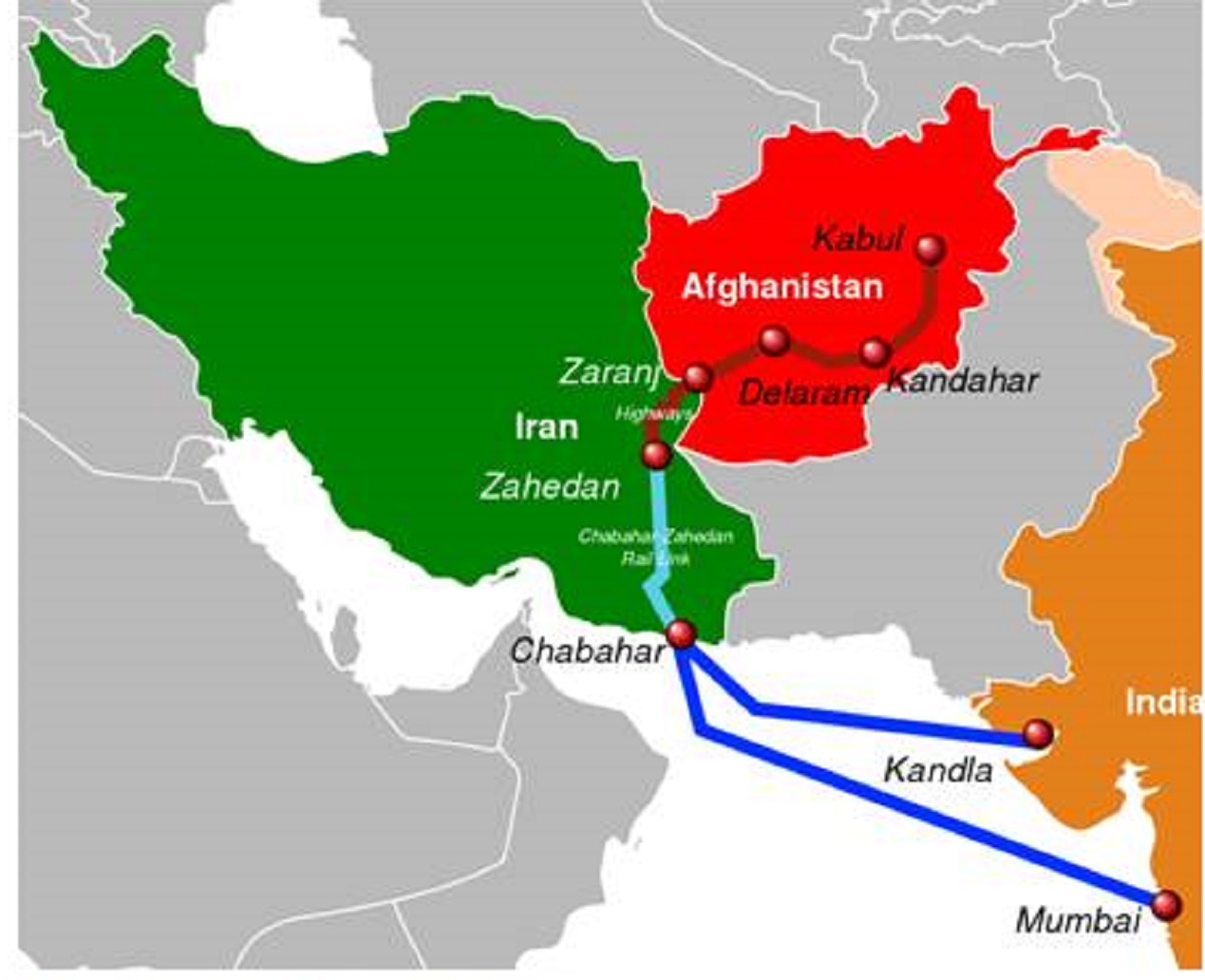









Post new comment